

Compact Muon Solenoid
LHC, CERN
| CMS-PAS-FTR-18-008 | ||
| Projection of searches for pair production of scalar leptoquarks decaying to a top quark and a charged lepton at the HL-LHC | ||
| CMS Collaboration | ||
| November 2018 | ||
| Abstract: Projections for searches for pair-produced scalar leptoquarks decaying into top quarks and muons or tau leptons for high integrated luminosities of up to 3000 fb$^{-1}$ at the high luminosity LHC are presented. This study is based on published analysis results of data recorded in the year 2016. It uses scaled signal and background templates to estimate the reach in terms of discovery potential and upper limits on the leptoquark pair production cross section. Two different ways of treating systematic uncertainties are studied. The mass reach for a 5$\sigma$ discovery or a 95% confidence level exclusion is expected to increase by 400 to 500 GeV with respect to the 2016 results. In the case of mixed decays between these two channels, the mass expected to be in reach for a 5$\sigma$ discovery and the expected 95% confidence level limit on excluded leptoquark masses ranges from 1200 to 1700 GeV and from 1400 to 1900 GeV depending on the value of the branching fraction, respectively. | ||
| Links: CDS record (PDF) ; inSPIRE record ; CADI line (restricted) ; | ||
| Figures | |

png pdf |
Figure 1:
Feynman diagrams of the gluon-induced production and the subsequent decay of a pair of LQs into top quarks and muons (left) and into top quarks and $\tau $ leptons with a subsequent decay of the two top quarks into the $\ell $+jets final state (right), where $\ell $ denotes an electron or muon. |
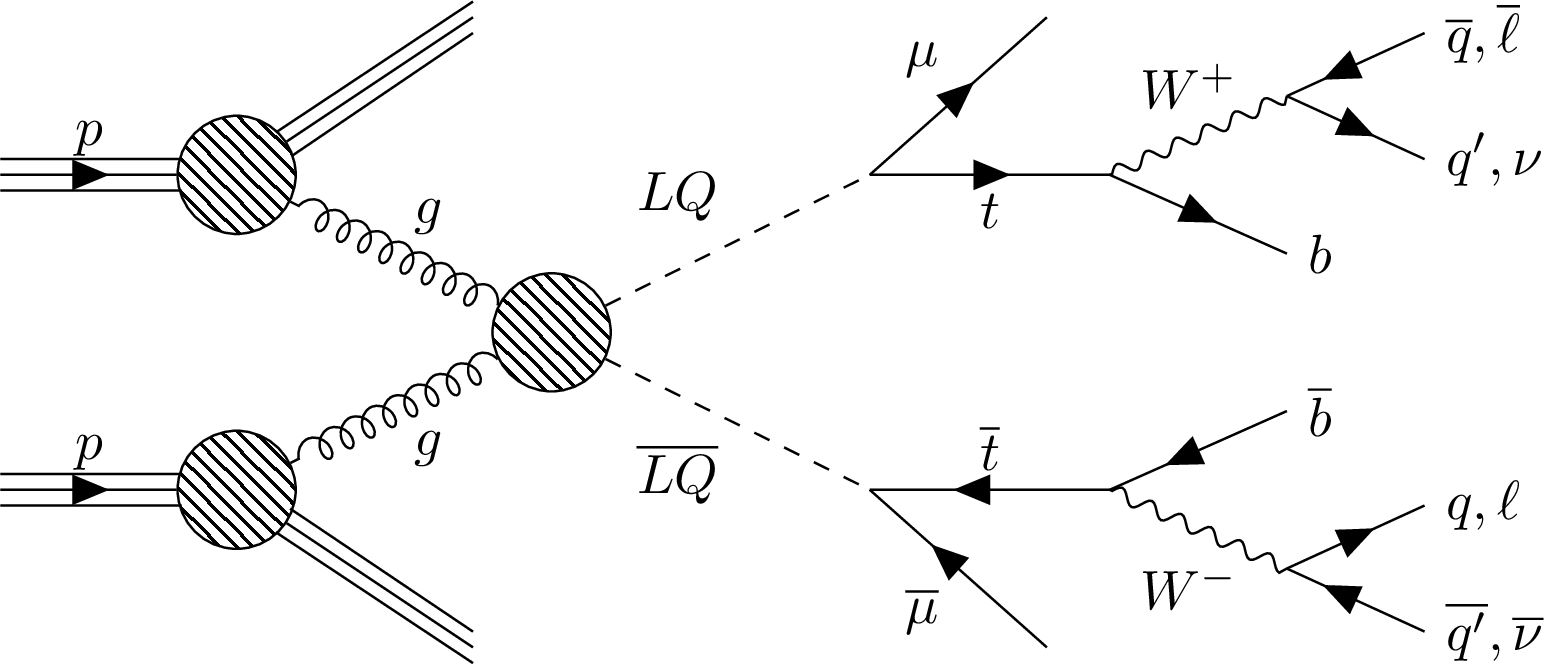
png pdf |
Figure 1-a:
Feynman diagram of the gluon-induced production and the subsequent decay of a pair of LQs into top quarks and muons. |

png pdf |
Figure 1-b:
Feynman diagram of the gluon-induced production and the subsequent decay of a pair of LQs into top quarks and $\tau $ leptons with a subsequent decay of the two top quarks into the $\ell $+jets final state, where $\ell $ denotes an electron or muon. |
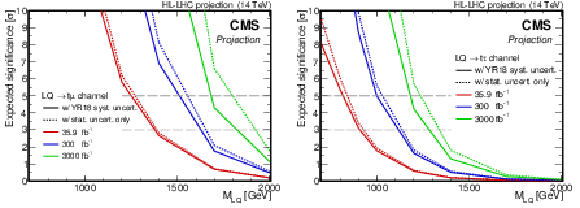
png pdf |
Figure 2:
Expected significances for an LQ decaying exclusively to top quarks and muons (left) or $\tau $ leptons (right) as a function of the LQ mass and for different integrated luminosities in the ''YR18 syst.'' (solid) and ''stat. only'' (dotted) scenarios. All results were obtained with templates for $\sqrt {s} = $ 13 TeV that were scaled to $\sqrt {s} = $ 14 TeV. |
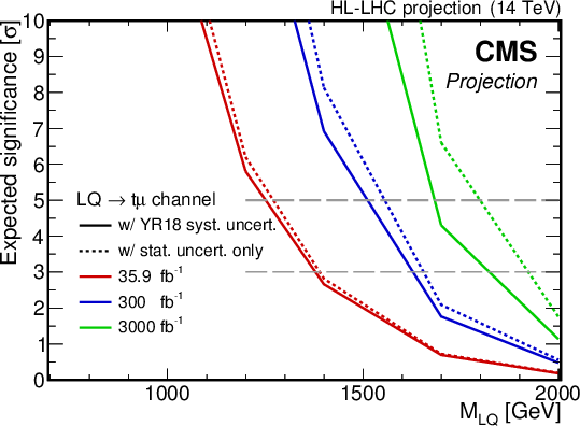
png pdf |
Figure 2-a:
Expected significances for an LQ decaying exclusively to top quarks and muons as a function of the LQ mass and for different integrated luminosities in the ''YR18 syst.'' (solid) and ''stat. only'' (dotted) scenarios. All results were obtained with templates for $\sqrt {s} = $ 13 TeV that were scaled to $\sqrt {s} = $ 14 TeV. |
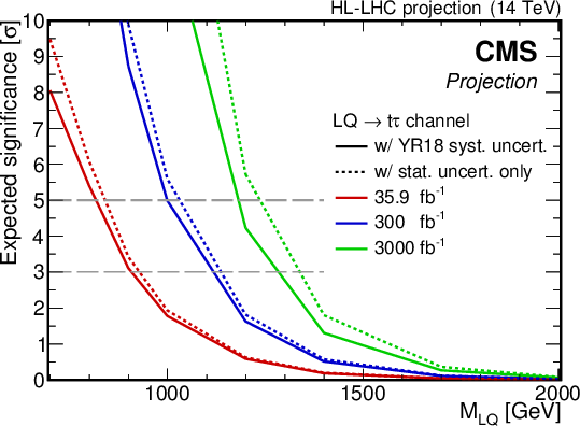
png pdf |
Figure 2-b:
Expected significances for an LQ decaying exclusively to top quarks and $\tau $ leptons as a function of the LQ mass and for different integrated luminosities in the ''YR18 syst.'' (solid) and ''stat. only'' (dotted) scenarios. All results were obtained with templates for $\sqrt {s} = $ 13 TeV that were scaled to $\sqrt {s} = $ 14 TeV. |
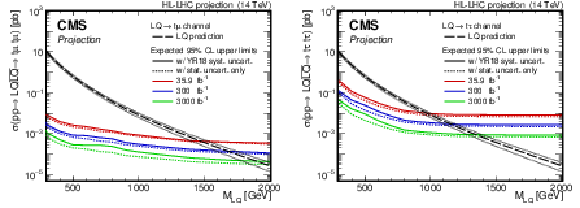
png pdf |
Figure 3:
Expected upper limits on the LQ pair production cross section at the 95% CL for an LQ decaying exclusively to top quarks and muons (left) or $\tau $ leptons (right) as a function of the LQ mass and for different integrated luminosities in the ''YR18 syst.'' (solid) and ''stat. only'' (dotted) scenarios. All results were obtained with templates for $\sqrt {s} = $ 13 TeV that were scaled to $\sqrt {s} = $ 14 TeV. The LQ pair production cross section was calculated at NLO [35], its uncertainty takes into account PDF and scale variations. |
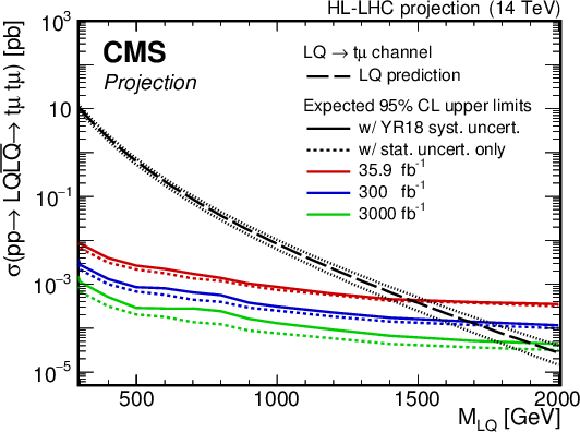
png pdf |
Figure 3-a:
Expected upper limits on the LQ pair production cross section at the 95% CL for an LQ decaying exclusively to top quarks and muons as a function of the LQ mass and for different integrated luminosities in the ''YR18 syst.'' (solid) and ''stat. only'' (dotted) scenarios. All results were obtained with templates for $\sqrt {s} = $ 13 TeV that were scaled to $\sqrt {s} = $ 14 TeV. The LQ pair production cross section was calculated at NLO [35], its uncertainty takes into account PDF and scale variations. |
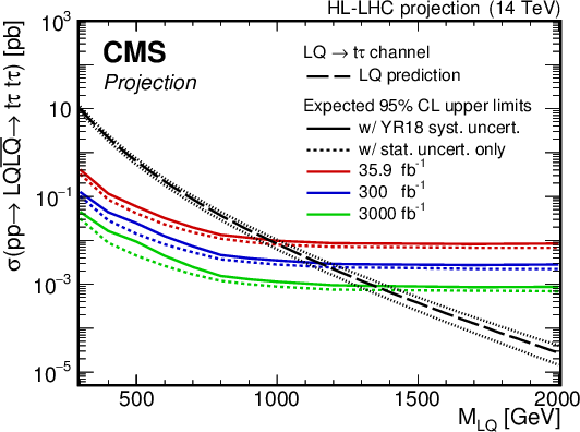
png pdf |
Figure 3-b:
Expected upper limits on the LQ pair production cross section at the 95% CL for an LQ decaying exclusively to top quarks and $\tau $ leptons as a function of the LQ mass and for different integrated luminosities in the ''YR18 syst.'' (solid) and ''stat. only'' (dotted) scenarios. All results were obtained with templates for $\sqrt {s} = $ 13 TeV that were scaled to $\sqrt {s} = $ 14 TeV. The LQ pair production cross section was calculated at NLO [35], its uncertainty takes into account PDF and scale variations. |
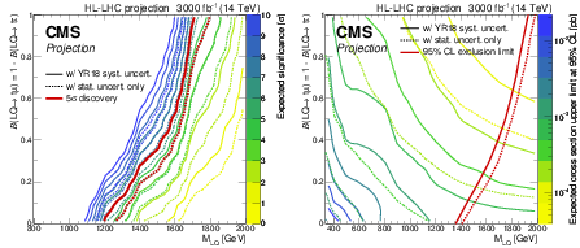
png pdf |
Figure 4:
Expected significances (left) and expected upper limits on the LQ pair-production cross section at the 95% CL (right) as a function of the LQ mass and the branching fraction at 3000 fb$^{-1}$ in the ''YR18 syst.'' and the ''stat. only'' scenarios. Color-coded lines represent lines of a constant expected significance or cross section limit, respectively. The red lines indicate the 5$\sigma $ discovery level (left) and the mass exclusion limit (right). |
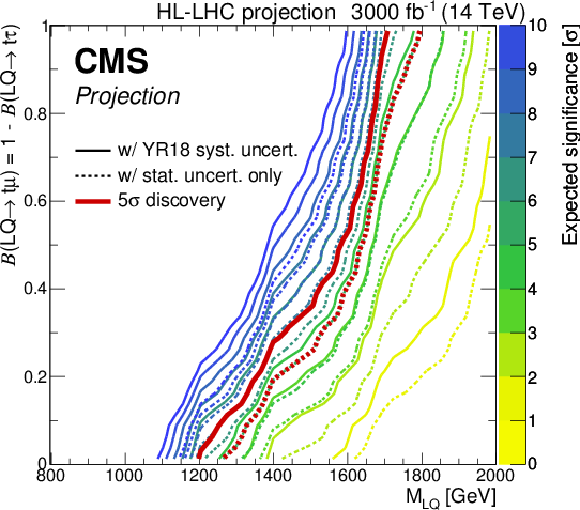
png pdf |
Figure 4-a:
Expected significances as a function of the LQ mass and the branching fraction at 3000 fb$^{-1}$ in the ''YR18 syst.'' and the ''stat. only'' scenarios. Color-coded lines represent lines of a constant expected significance. The red lines indicate the 5$\sigma $ discovery level. |

png pdf |
Figure 4-b:
Expected upper limits on the LQ pair-production cross section at the 95% CL as a function of the LQ mass and the branching fraction at 3000 fb$^{-1}$ in the ''YR18 syst.'' and the ''stat. only'' scenarios. Color-coded lines represent lines of a constant expected cross section limit. The red lines indicate the mass exclusion limit. |
| Tables | |
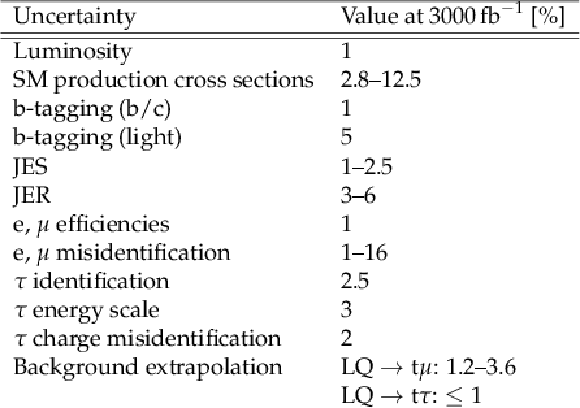
png pdf |
Table 1:
Scaled relative systematic uncertainties in the ''YR18 syst.'' scenario at $\mathcal {L}_{\text {int}}^{\text {target}}= $ 3000 fb$^{-1} $. |
| Summary |
| Projections for searches for pair production of scalar leptoquarks decaying into top quarks and muons or $\tau$ leptons at the high-luminosity LHC have been presented. They are based on published analyses of the dataset recorded by the CMS experiment in 2016. The effect of an increased center-of-mass energy of $\sqrt{s} = $ 14 TeV and the impact of reduced systematic uncertainties have been taken into account. The results of the analyses of the 2016 dataset are expected to be improved significantly with an integrated luminosity of 3000 fb$^{-1}$. |
| References | ||||
| 1 | W. Buchmuller and D. Wyler | Constraints on SU(5)-type leptoquarks | PLB 177 (1986) 377 | |
| 2 | J. C. Pati and A. Salam | Lepton number as the fourth color | PRD 10 (1974) 275, .[Erratum: \DOI10.1103/PhysRevD.11.703.2] | |
| 3 | H. Georgi and S. L. Glashow | Unity of all elementary-particle forces | PRL 32 (1974) 438 | |
| 4 | H. Fritzsch and P. Minkowski | Unified interactions of leptons and hadrons | Annals Phys. 93 (1975) 193 | |
| 5 | E. Farhi and L. Susskind | Technicolor | PR 74 (1981) 277 | |
| 6 | K. Lane and M. V. Ramana | Walking technicolor signatures at hadron colliders | PRD 44 (1991) 2678 | |
| 7 | B. Schrempp and F. Schrempp | Light leptoquarks | PLB 153 (1985) 101 | |
| 8 | B. Gripaios | Composite leptoquarks at the LHC | JHEP 02 (2010) 045 | 0910.1789 |
| 9 | M. Tanaka and R. Watanabe | New physics in the weak interaction of $ \bar B\to D^{(*)}\tau\bar\nu $ | PRD 87 (2013) 034028 | 1212.1878 |
| 10 | Y. Sakaki, M. Tanaka, A. Tayduganov, and R. Watanabe | Testing leptoquark models in $ \bar B \to D^{(*)} \tau \bar\nu $ | PRD 88 (2013) 094012 | 1309.0301 |
| 11 | I. Dor$\text\us$ner, S. Fajfer, N. Ko$\text\us$nik, and I. Ni$\text\us$and$\text\vz$i\'c | Minimally flavored colored scalar in $ \bar B \to D^{(*)} \tau \bar \nu $ and the mass matrices constraints | JHEP 11 (2013) 084 | 1306.6493 |
| 12 | B. Dumont, K. Nishiwaki, and R. Watanabe | LHC constraints and prospects for $ S_1 $ scalar leptoquark explaining the $ \bar B \to D^{(*)} \tau \bar\nu $ anomaly | PRD 94 (2016) 034001 | 1603.05248 |
| 13 | A. Crivellin, C. Greub, F. Saturnino, and D. Muller | Importance of loop effects in explaining the accumulated evidence for new physics in B decays with a vector leptoquark | 1807.02068 | |
| 14 | A. Crivellin, D. Muller, and T. Ota | Simultaneous explanation of R(D$ ^{(*)} $) and $ \text{b}\rightarrow\text{s}\mu^{+}\mu^{-} $: the last scalar leptoquarks standing | JHEP 09 (2017) 040 | 1703.09226 |
| 15 | B. Gripaios, M. Nardecchia, and S. A. Renner | Composite leptoquarks and anomalies in $ b $-meson decays | JHEP 05 (2015) 006 | 1412.1791 |
| 16 | M. Bauer and M. Neubert | Minimal leptoquark explanation for the $ R_{D^{(*)}} $, $ R_K $ , and $ (g-2)_\mu $ anomalies | PRL 116 (2016) 141802 | 1511.01900 |
| 17 | E. Coluccio Leskow, G. D'Ambrosio, A. Crivellin, and D. Muller | $ (g-2)_\mu $, lepton flavor violation, and $ Z $ decays with leptoquarks: Correlations and future prospects | PRD 95 (2017) 055018 | 1612.06858 |
| 18 | D. Be$\text\uc$irevi\'c and O. Sumensari | A leptoquark model to accommodate $ R_K^\mathrm{exp} < R_K^\mathrm{SM} $ and $ R_{K^\ast}^\mathrm{exp} < R_{K^\ast}^\mathrm{SM} $ | JHEP 08 (2017) 104 | 1704.05835 |
| 19 | G. Hiller and I. Ni$\text\us$and$\text\vz$i\'c | $ R_K $ and $ R_{K^{\ast}} $ beyond the standard model | PRD 96 (2017) 035003 | 1704.05444 |
| 20 | G. Hiller, D. Loose, and I. Ni$\text\us$and$\text\vz$i\'c | Flavorful leptoquarks at hadron colliders | PRD 97 (2018) 075004 | 1801.09399 |
| 21 | BaBar Collaboration | Evidence for an excess of $ \bar{B} \to D^{(*)} \tau^-\bar{\nu}_\tau $ decays | PRL 109 (2012) 101802 | 1205.5442 |
| 22 | BaBar Collaboration | Measurement of an excess of $ \bar{B} \to D^{(*)}\tau^- \bar{\nu}_\tau $ decays and implications for charged higgs bosons | PRD 88 (2013) 072012 | 1303.0571 |
| 23 | Belle Collaboration | Observation of $ B^0 \rightarrow D^{*-} \tau^+ \nu_{\tau} $ decay at Belle | PRL 99 (2007) 191807 | 0706.4429 |
| 24 | Belle Collaboration | Observation of $ B^+ \rightarrow \bar{D}^{*0} \tau^+ \nu_{\tau} $ and evidence for $ B^+ \rightarrow \bar{D}^0 \tau^+ \nu_{\tau} $ at Belle | PRD 82 (2010) 072005 | 1005.2302 |
| 25 | Belle Collaboration | Measurement of the branching ratio of $ \bar{B} \to D^{(\ast)} \tau^- \bar{\nu}_\tau $ relative to $ \bar{B} \to D^{(\ast)} \ell^- \bar{\nu}_\ell $ decays with hadronic tagging at Belle | PRD 92 (2015) 072014 | 1507.03233 |
| 26 | LHCb Collaboration | Measurement of the ratio of branching fractions $ \mathcal{B}(\bar{B}^0 \to D^{*+}\tau^{-}\bar{\nu}_{\tau})/\mathcal{B}(\bar{B}^0 \to D^{*+}\mu^{-}\bar{\nu}_{\mu}) $ | PRL 115 (2015) 111803 | 1506.08614 |
| 27 | LHCb Collaboration | Test of Lepton Flavor Universality by the measurement of the $ B^0 \to D^{*-} \tau^+ \nu_{\tau} $ branching fraction using three-prong $ \tau $ decays | PRD 97 (2018) 072013 | 1711.02505 |
| 28 | HFLAV Collaboration | Averages of $ b $-hadron, $ c $-hadron, and $ \tau $-lepton properties as of summer 2016 | EPJC 77 (2017) 895 | 1612.07233 |
| 29 | LHCb Collaboration | Test of lepton universality using $ B^{+}\to K^{+}\ell^{+}\ell^{-} $ decays | PRL 113 (2014) 151601 | 1406.6482 |
| 30 | LHCb Collaboration | Differential branching fractions and isospin asymmetries of $ B \to K^{(*)} \mu^+ \mu^- $ decays | JHEP 06 (2014) 133 | 1403.8044 |
| 31 | LHCb Collaboration | Angular analysis of the $ B^{0} \to K^{*0} \mu^{+}\mu^{-} $ decay using 3 fb$ ^{-1} $ of integrated luminosity | JHEP 02 (2016) 104 | 1512.04442 |
| 32 | LHCb Collaboration | Test of lepton universality with $ B^{0} \rightarrow K^{*0}\ell^{+}\ell^{-} $ decays | JHEP 08 (2017) 055 | 1705.05802 |
| 33 | Muon g-2 Collaboration | Final report of the muon E821 anomalous magnetic moment measurement at BNL | PRD 73 (2006) 072003 | hep-ex/0602035 |
| 34 | M. Davier, A. Hoecker, B. Malaescu, and Z. Zhang | Reevaluation of the hadronic vacuum polarisation contributions to the standard model predictions of the muon $ g-2 $ and $ {\alpha (m_z^2)} $ using newest hadronic cross-section data | EPJC 77 (2017) 827 | 1706.09436 |
| 35 | M. Kramer, T. Plehn, M. Spira, and P. M. Zerwas | Pair production of scalar leptoquarks at the CERN LHC | PRD 71 (2005) 057503 | hep-ph/0411038 |
| 36 | G. Apollinari et al. | High-Luminosity Large Hadron Collider (HL-LHC) : Preliminary Design Report | ||
| 37 | CMS Collaboration | Search for leptoquarks coupled to third-generation quarks in proton-proton collisions at $ \sqrt{s}= $ 13 TeV | Submitted to PRL (2018) | CMS-B2G-16-027 1809.05558 |
| 38 | CMS Collaboration | Search for third-generation scalar leptoquarks decaying to a top quark and a $ \tau $ lepton at $ \sqrt{s}= $ 13 TeV | EPJC 78 (2018) 707 | CMS-B2G-16-028 1803.02864 |
| 39 | J. Ott | Theta --- A framework for template-based modeling and inference | 2010 \url http://www-ekp.physik.uni-karlsruhe.de/\ ott/theta/theta-auto | |
| 40 | A. O'Hagan and J. J. Forster | Kendall's advanced theory of statistics. Vol. 2B: Bayesian Inference | ||
| 41 | G. Cowan, ``Statistics'', Ch. 39 in Particle Data Group, C. Patrignani et al. | Statistics'', Ch. 39 in Particle Data Group, C.~Patrignani et~al., ``Review of particle physics | CPC 40 (2016) 100001 | |
| 42 | CMS Collaboration | The CMS Experiment at the CERN LHC | JINST 3 (2008) S08004 | CMS-00-001 |

|
Compact Muon Solenoid LHC, CERN |

|

|

|

|

|

|